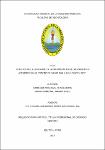Efectos de la lidocaína en la presión arterial de pacientes atendidos en el Centro De Salud San Juan, Loreto- 2018

View/
Date
2019Author
Chiroque Mendoza, Thalía Oshin
Bravo Moreyra, Sammir Jesus
Metadata
Show full item recordAbstract
OBJETIVO: El presente estudio, tuvo como objetivo determinar los efectos de la lidocaína en la presión arterial de pacientes atendidos en el centro de salud san juan de Miraflores, 2018.
MATERIALES Y METODOS: El presente estudio fue cuantitativo aplicada, no experimental, descriptivo comparativo, transversal. La muestra estuvo conformada por 234 pacientes atendidos en centro de salud San Juan de Miraflores en el 2018. El instrumento utilizado fue la medición de la presión arterial antes de la infiltración de lidocaína, después de 10 min y después de terminado el tratamiento. Para determinar la variación de la presión arterial se utilizará tensiómetro electrónico registrar la información en el instrumento.
RESULTADOS: El sexo femenino representó el 66,7% y el masculino el 33,3%. El 92,3% no tuvo antecedentes de complicaciones, el 3,8% presentó hemorragia, el 2,1% mareos, el 1,3% alveolitis seca y el 0,4% sueño. El 54,3% de la muestra se consideró paciente ansioso. El 33,3% utilizó un cartucho de anestesia, seguido del 32,5% utilizó 2 cartuchos, el 18,4% utilizó 1,5 cartuchos, el 7,7% utilizó 3 cartuchos, el 7,3% utilizó 2,5 cartuchos, el 0,4% usó 0,5 y 4 cartuchos. El promedio de la presión sistólica inicial fue 117,77+11,99; de la presión sistólica media fue 121,63+11,32 y la presión sistólica final fue 120,42+11,12. El promedio de la presión diastólica inicial fue 70,19+8,41; de la presión diastólica media fue 70,62+7,74 y la presión diastólica final fue 70,24+9,03. El 61,5% de pacientes del sexo femenino se considera ansiosa y el 39,7% del sexo masculino se considera ansioso. No existe relación entre el sexo de los pacientes y los antecedentes de complicaciones (p=0,905). Existen diferencias significativas en la presión sistólica inicial, media y final (p-0,000). Existen diferencias significativas en la presión diastólica inicial, media y final (p-0,000). Existen diferencias significativas en pacientes que se consideran ansiosos en la presión sistólica inicial, media y final (p=0,000), también existen diferencias significativas para los no ansiosos (p=0,000).
CONCLUSIÓN: La lidocaína produce cambios significativos en la presión arterial. Existen diferencias significativas en la presión sistólica inicial, media y final para la técnica infiltrativa (p=0,000), troncular (p=0,020), infiltrativa/troncular (p=0,000), infiltrativa/intraseptal (0,017), no hubo diferencias para troncular/infiltrativa/intraseptal (p=0,247). OBJECTIVE: The objective of this study was to determine the effects of lidocaine on the blood pressure of patients treated at the San Juan de Miraflores health center, 2018.
MATERIALS AND METHODS: The present study was quantitative applied, not experimental, descriptive, comparative, transversal. The sample consisted of 234 patients treated at the San Juan de Miraflores health center in 2018. The instrument used was the measurement of blood pressure before the infiltration of lidocaine, after 10 min and after the end of treatment. To determine the variation of blood pressure, an electronic blood pressure monitor will be used to record the information in the instrument.
RESULTS: The female sex represented 66.7% and the male 33.3%. 92.3% had no history of complications, 3.8% presented haemorrhage, 2.1% dizziness, 1.3% had dry socket and 0.4% had sleepiness. 54.3% of the sample was considered anxious patient. 33.3% used an anesthesia cartridge, followed by 32.5% using 2 cartridges, 18.4% using 1.5 cartridges, 7.7% using 3 cartridges, 7.3% using 2.5 cartridges, 0.4% used 0.5 and 4 cartridges. The mean initial systolic pressure was 117.77 + 11.99; of the mean systolic pressure was 121.63 + 11.32 and the final systolic pressure was 120.42 + 11.12. The mean initial diastolic pressure was 70.19 + 8.41; The mean diastolic pressure was 70.62 + 7.74 and the final diastolic pressure was 70.24 + 9.03. 61.5% of female patients are considered anxious and 39.7% of males is considered anxious. There is no relationship between the sex of the patients and the history of complications (p = 0.905). There are significant differences in the initial, mean and final systolic pressure (p-0.000). There are significant differences in the initial, middle and final diastolic pressure (p-0.000). There are significant differences in patients who are considered anxious in the initial, middle and final systolic pressure (p = 0.000), there are also significant differences for the non-anxious (p = 0.000).
CONCLUSION: Lidocaine produces significant changes in blood pressure. There are significant differences in the initial, mean and final systolic pressure for the infiltrative technique (p = 0.000), truncal (p = 0.020), infiltrative / truncal (p = 0.000), infiltrative / intraseptal (0.017), there were no differences for truncular / infiltrative / intraseptal (p = 0.247).
Collections
- Tesis [188]
The following license files are associated with this item:

